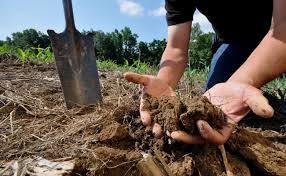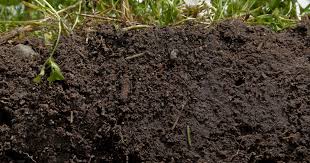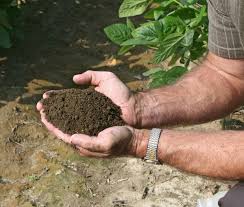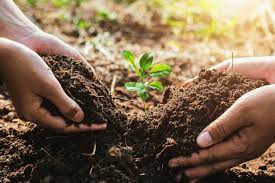Soil management is the application of operations, practices, and treatments to protect soil and enhance its performance (such as soil fertility or soil mechanics).
It includes soil conservation, soil amendment, and the promotion of optimal soil health. In agriculture, soil management is essential in both organic and non-organic systems to prevent farmland from becoming unproductive over time.
Organic farming places greater emphasis on soil management, as it relies primarily on soil health for fertilization and pest control.
Soil management seeks to maintain the soil in good condition or to improve it when needed. This includes protecting the soil from direct sunlight, rainfall, and wind erosion.
In annual crops like vegetables and flowers where there is little to no vacant space, the main concern is nutrient replenishment due to crop harvest and nutrient leaching.
For tree crops, several years may pass before a tree develops a wide canopy to shield the soil. During this period, vacant spaces must be utilized and protected using practices such as intercropping, cover cropping, cultivation, sod culture, mulching, rotation, and high-density planting.
Read Also: Chiggers: Description, Damages Caused, Control and Preventive Measures
Definition and Objectives of Soil Management in Crop and Tree Production

Soil management practice is the process of maintaining the soil in good condition and improving its quality and nutritional status by protecting it from direct sunlight, rainfall, and wind erosion.
In annual crops like vegetables and flowers where vacant spaces are minimal, the main challenge is replacing nutrients taken up by crops or lost through leaching.
In tree crops, several years may elapse before the canopy provides sufficient soil protection. During this time, proper soil utilization and protection are required through various practices such as intercropping, cover cropping, cultivation, sod culture, mulching, rotation, and high-density planting.
Objectives of soil management include the following:
1. Create favourable conditions for moisture supply and proper drainage.
2. Maintain high fertility levels and replenish nutrient losses.
3. Provide soil conditions that support gaseous exchange and microbial activity through organic matter addition.
4. Control or reduce soil erosion.
5. Ensure the availability of nutrients for plant growth and development.
6. Maximize the use of vacant land to generate additional income, especially for smallholders.
7. Reduce the cost of cultivation while increasing economic returns.
8. Suppress weed population.
Key Components of Soil Management in Agricultural Systems
The main goal of soil management is to enhance soil fertility. This is achieved through three interrelated components:
1. Physical Component (e.g., water-holding capacity, soil structure).
2. Chemical Component (e.g., nutrient availability, soil pH).
3. Biological Component (e.g., activity and diversity of soil organisms).
A fertile soil is one with well-managed organic matter, strong structure, diverse biological life, and high water and nutrient-holding capacity. Compost and stable manure play a key role in improving these properties.
Common Soil Management Methods for Agricultural Productivity
Proper soil management methods are essential for weed control, incorporation of organic and inorganic fertilisers, and enhancement of water absorption. Common practices include:
1. Cultivation
2. Sod Culture
3. Mulching
4. Crop Rotation
The selection of an appropriate method depends on several factors:
- Type of crop
- Rooting depth of the crop
- Soil slope
- Rainfall pattern
- Climatic conditions
- Farmer’s economic situation
Read Also: Scrapie in Sheep and Goats: Description, Damages Caused, Control and Preventive Measures
Cultivation Practices in Soil Management

Cultivation involves working the soil through ploughing, harrowing, disking, or hoeing. It removes weeds, incorporates fertilisers, and improves water and nutrient uptake by enhancing aeration.
The depth and area for tillage depend on the tree’s root spread and canopy size. Cultivation methods are modified based on specific conditions.
1. Clean Cultivation and Its Role in Soil Management
Clean cultivation keeps the space between plants free from weeds through regular tillage.
i. Advantages of clean cultivation:
1. Eliminates weed competition for light, water, and nutrients, and reduces alternate hosts for pests and diseases.
2. Enhances soil aeration by breaking clods.
3. Breaks hard soil layers and improves water infiltration.
4. Boosts biological activity by increasing aeration.
ii. Disadvantages of clean cultivation:
1. Reduces organic matter.
2. Leads to soil loss through erosion by water and wind, even on flat land.
3. Causes nutrient leaching.
4. Can damage roots and create entry points for pathogens.
Due to these drawbacks, clean cultivation is not advised in fruit orchards, except before planting. Intercropping with short-duration or nitrogen-fixing crops is often preferred. Cultivation should be shallow, infrequent, and stopped at flowering.
Cover Cropping as a Soil Management Practice
In erosion-prone and poorly drained areas, cultivation is followed by growing cover crops between crop rows. These crops may or may not be incorporated into the soil.
They improve water retention, add organic matter, and prevent erosion. Legumes are preferred for their nitrogen-fixing abilities and weed suppression.
i. Advantages of cover crops:
1. Add organic matter to the soil.
2. Improve soil structure and fertility.
3. Enhance water retention.
4. Promote biological activity.
5. Reduce soil erosion and nutrient loss.
Intercropping and Its Benefits in Orchard Soil Management
In orchard soil management, cultivation is used for intercropping—growing multiple crops on the same field simultaneously.
Intercropping improves crop productivity through efficient use of time and space and creates competition between crops for available resources.
In orchards or plantations, intercropping typically involves short-duration or annual crops during the early growth years of trees.
Mixed cropping involves growing other perennials between existing perennials. Multistory cropping includes combinations of annuals and perennials in the same space.
Sod Culture and Minimum Tillage in Soil Management

This system allows grasses to grow between tree rows without tillage or mulching. Sometimes, grasses are mixed with legumes to improve soil fertility. The vegetation is mowed to keep the orchard neat.
This method is commonly practiced in temperate regions such as Europe and America for apple and pear orchards. It is not suitable in tropical and subtropical regions of India due to nutrient and moisture limitations.
i. Benefits of sod culture:
- Controls soil erosion
- Maintains soil organic matter
- Enhances soil structure
ii. Common modifications in sod culture include:
1. Grasses grown without cutting (not desirable due to organic matter loss).
2. Grasses cut and removed as hay (also causes organic matter loss).
3. Grasses cut and left to decompose.
4. Grasses grazed by animals.
5. Temporary sod followed by ploughing and reseeding.
6. Unsuitable in India due to climatic limitations.
7. Poor aeration and rodent problems can harm tree roots.
8. Nutrient deficiencies, especially potassium, are common.
iii. Minimum Tillage and Its Adaptation in Agriculture
Minimum tillage avoids traditional tillage operations such as ploughing and harrowing. It is suitable for uneven terrain. Herbicides are used to kill existing vegetation, forming a layer of dead plant material that reduces erosion, retains moisture, and gradually releases nutrients.
Mulching as a Key Practice in Soil Management
Mulching involves covering the soil around plants with materials like straw, hay, crop residue, leaves, sawdust, or plastic. It conserves moisture, reduces weed growth, and improves growing conditions. It is a widely adopted method in orchards across many countries.
Advantages of mulching:
- Moisture conservation
- Weed suppression
- Soil temperature regulation
- Nutrient preservation
Do you have any questions, suggestions, or contributions? If so, please feel free to use the comment box below to share your thoughts. We also encourage you to kindly share this information with others who might benefit from it. Since we can’t reach everyone at once, we truly appreciate your help in spreading the word. Thank you so much for your support and for sharing!

